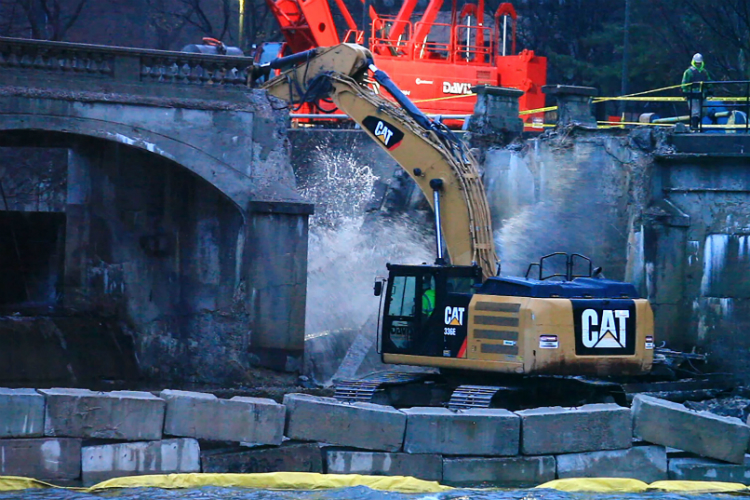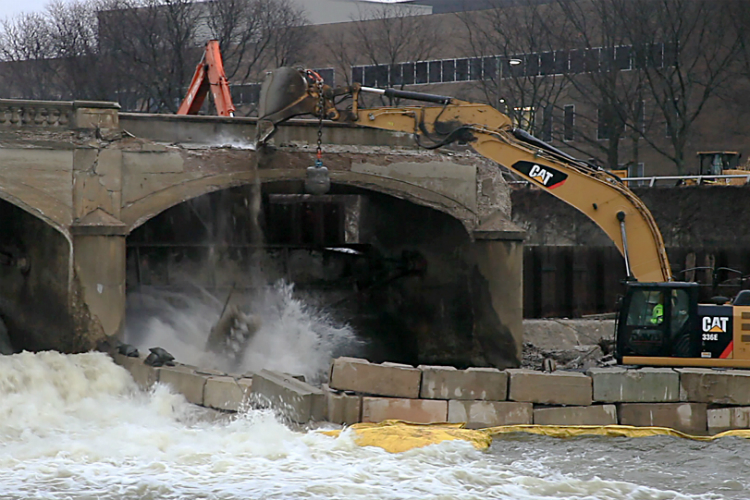This view of the Flint river will soon look $37 million better
Work to remove the Hamilton Dam—and create green spaces, spur economic development, and increase recreation along the Flint River—continues.
Portions of concrete and steel crumpled like flakes of dust, crashing down with the steady early morning rain pelting the surface of the water. As crews began knocking down the Hamilton Dam, the Flint Riverfront Restoration project officially kicked off with creaking, smashing and big splashes.
A few people came out to see the old dam come down and all those in attendance agreed, it was long overdue for the 1920s structure. “Our community has been trying to take out this dam for a very long time,” said Janet Van De Winkle, project director for the Genesee County Parks.
And, this is the beginning. Work is continuing to remove the dam, that long ago was deemed too dangerous for pedestrians to use the bridge portion crossing the Flint River.
“We are working to make the river more accessible to everybody, currently this stretch downtown is difficult and unsafe to access. Connecting people to the river, whether for fishing, to sit and have a picnic, walk along the Flint River Trail or paddle down the river- that’s what this project is all about,” Van De Winkle said.
In 2008, the inspectors from the State of Michigan gave the dam the lowest safety rating possible, calling it a high hazard and in critical condition.
The total cost for the project comes in at $37 million and is designed to create green spaces, spur economic development, increase recreational opportunities and, ultimately, improving the river and residents’ quality of life.
The project also transforms a river that has been a point of contention and rife with misunderstanding, especially stemming from the Flint water crisis, which was not caused by the Flint River water itself but was a result of how water was treated and improper monitoring that led to criminal charges being filed against a host of local and state employees.
According to the map and details on the restoration site map, the park will encompass 1.5 miles of the river and include hiking and bike paths as it cuts on a slanted parallel to the revitalized University Corridor area. After the Hamilton and Fabri dams are removed additional work will need to be done to make the river safe and accessible for paddling. Buoys will be placed upstream to warn paddlers until that additional phase of work is complete.
“This is a project that we have been promoting for over a decade. It’s a dam that hasn’t served any real purpose for a really long time, it’ll be safer having come down, and it is a big first step to re-naturalize the city stretch of the river system,” said Rebecca Fedewa, director of the Flint River Watershed Coalition.
Lifelong resident Michael Wilson came down in the early hours to see the start of what he says, “is something good and long overdue for Flint.” Wilson remembers coming down to the riverfront after a show at the old IMA and when Auto World was first constructed.
Wilson doesn’t fish and doesn’t boat, so his interest isn’t really in having better access to the river. Instead, his interest is simply making Flint a better place.
“It is time that we clean it up. It’s time that we can show some pride in this area and take better care of the river,” he says.
Looking around in the mid-morning rain amongst the crash of concrete and twisting metal, Wilson laughs with a kind Midwestern pronouncement. “You know it, I’ve done all my living in Flint. All my family, all my time is here in Flint, so it’d be nice to have it cleaned up along here and give people more reasons to spend more time in the city, maybe change others’ minds about what we still got here.”









